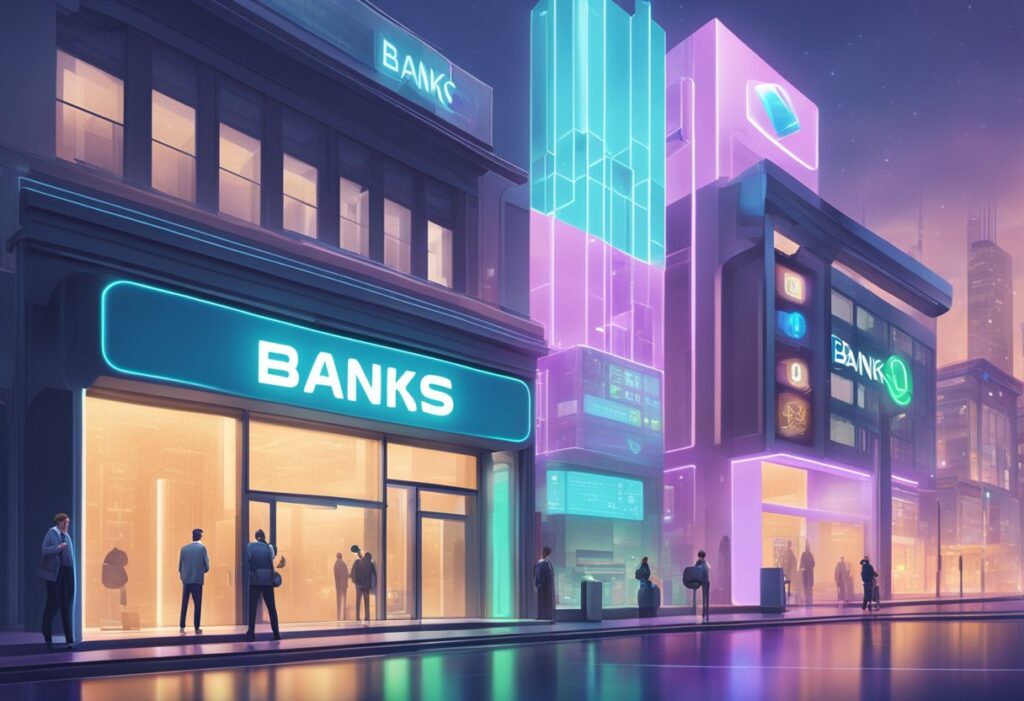Banks have been exploring the potential of the metaverse, a virtual world that allows players to interact with each other in a simulated environment. The metaverse has become a popular destination for gamers and investors alike, with many predicting that it could become the next big thing in technology. Banks are keen to explore the possibilities of this new world, with some setting up virtual branches in the metaverse to test out new products and services.
One of the main advantages of the metaverse is that it allows banks to reach a younger audience. Many gamers are in their teens and twenties, and banks are keen to tap into this demographic. By setting up virtual branches in the metaverse, banks can offer a range of financial products and services to this audience, including loans, savings accounts, and investment opportunities.
However, there are also challenges associated with the metaverse. One of the biggest concerns for banks is security. As virtual worlds become more sophisticated, there is a risk that hackers could exploit vulnerabilities in the system to steal personal information or assets. Banks will need to invest heavily in security measures to ensure that their customers are protected in the metaverse.
Banking in the Metaverse

The metaverse is a virtual world where users can interact with each other in a shared space. It is a place where people can socialize, work, and even conduct business transactions. Banks are starting to explore the potential of the metaverse and how they can use it to provide innovative financial services.
Metaverse Banking Services
Metaverse banking services are financial services that are provided within the metaverse. These services can include virtual bank accounts, virtual credit cards, and virtual loans. These services are designed to provide users with a seamless and convenient banking experience within the metaverse.
Virtual Branches and Real Estate
Virtual branches are digital representations of physical bank branches within the metaverse. These virtual branches can be used to provide users with access to banking services and financial information. Banks can also use virtual real estate within the metaverse to create a presence and attract customers.
Digital Assets and NFTs
Digital assets and non-fungible tokens (NFTs) are becoming increasingly popular within the metaverse. Banks can use these digital assets to provide users with innovative financial products. For example, banks can issue NFTs that represent ownership in a virtual asset or a share in a virtual company.
How Many Banks in the Metaverse
At present, only a few banks have a presence in the metaverse. However, more banks are starting to explore the potential of the metaverse and how they can use it to provide innovative financial services.
Metaverse Banking Use Cases
The potential use cases for metaverse banking are vast. Banks can use the metaverse to provide users with access to financial services in a convenient and innovative way. For example, users can conduct virtual transactions, access virtual ATMs, and even apply for virtual loans. The metaverse also provides banks with an opportunity to reach new audiences, including a younger, NFT-savvy generation.
Banks are starting to explore the potential of the metaverse and how they can use it to provide innovative financial services. Metaverse banking services can include virtual branches, digital assets, and NFTs. While only a few banks have a presence in the metaverse, more are starting to explore the potential of this virtual world.
Top Banks in the Metaverse

The growing popularity of the metaverse has prompted many banks to explore this new frontier. Here are some of the major banks that have established a presence in the metaverse:
1. JPMorgan Chase
JPMorgan Chase, the largest bank in the United States, was the first major bank to set up shop in the metaverse. In February 2022, the company opened the “Onyx Lounge” in the metaverse. The lounge is a virtual space where customers can interact with the bank’s products and services in a new and immersive way.
2. Bank of America
Bank of America has also established a presence in the metaverse. The bank has created a virtual branch where customers can access a range of financial services, including loans, mortgages, and investments. The bank is also exploring the use of virtual reality technology to enhance the customer experience.
3. Wells Fargo
Wells Fargo has established a virtual branch in the metaverse, where customers can access a range of financial services. The bank is also exploring the use of blockchain technology to improve the security and efficiency of its operations.
4. Citigroup
Citigroup has established a presence in the metaverse through its subsidiary, Citi Ventures. The company is exploring the use of blockchain technology to improve the efficiency of its operations and is also exploring the use of virtual reality technology to enhance the customer experience.
5. Goldman Sachs
Goldman Sachs has established a virtual branch in the metaverse, where customers can access a range of financial services. The bank is also exploring the use of blockchain technology to improve the security and efficiency of its operations.
6. HSBC
HSBC has established a presence in the metaverse through its subsidiary, HSBC Ventures. The company is exploring the use of blockchain technology to improve the efficiency of its operations and is also exploring the use of virtual reality technology to enhance the customer experience.
7. Morgan Stanley
Morgan Stanley has established a virtual branch in the metaverse, where customers can access a range of financial services. The bank is also exploring the use of blockchain technology to improve the security and efficiency of its operations.
8. Deutsche Bank
Deutsche Bank has established a presence in the metaverse through its subsidiary, Deutsche Bank Ventures. The company is exploring the use of blockchain technology to improve the efficiency of its operations and is also exploring the use of virtual reality technology to enhance the customer experience.
9. UBS
UBS has established a virtual branch in the metaverse, where customers can access a range of financial services. The bank is also exploring the use of blockchain technology to improve the security and efficiency of its operations.
10. Barclays
Barclays has established a presence in the metaverse through its subsidiary, Barclays Ventures. The company is exploring the use of blockchain technology to improve the efficiency of its operations and is also exploring the use of virtual reality technology to enhance the customer experience.
The major banks are exploring the metaverse as a new frontier for financial services. By establishing a presence in the metaverse, these banks are hoping to offer their customers a new and immersive way to interact with their products and services.
Business and Customer Engagement

In the metaverse, businesses have the opportunity to engage with customers in new and innovative ways that were not possible before. The following subsections explore some of the ways in which businesses can use the metaverse to enhance their engagement with customers.
New Marketing Opportunities
The metaverse provides businesses with new marketing opportunities that were not possible before. In the metaverse, businesses can create virtual storefronts, where customers can browse and purchase products in a virtual environment. This provides businesses with a unique opportunity to showcase their products in a new and innovative way, which can lead to increased revenue and customer engagement.
Customer Acquisition and Retention
The metaverse can also be used to acquire and retain customers. In the metaverse, businesses can create immersive experiences that allow customers to interact with their products and services in a way that was not possible before. This can lead to increased customer engagement and loyalty, which can ultimately lead to increased revenue and customer retention.
Innovative Payment Solutions
The metaverse also provides businesses with the opportunity to create innovative payment solutions. In the metaverse, businesses can create their own virtual currencies, which can be used to purchase products and services in the virtual environment. This can lead to increased revenue and customer engagement, as customers are more likely to engage with businesses that offer innovative payment solutions.
The metaverse provides businesses with new and innovative ways to engage with customers and enhance their customer experience. By leveraging the opportunities provided by the metaverse, businesses can increase their revenue and customer engagement, ultimately leading to increased success in the world of commerce.
The Future of Financial Services
The metaverse is a new frontier for financial services, and it presents emerging trends, challenges and regulations, as well as educational and investment opportunities.
Emerging Trends in Metaverse Banking
The metaverse is a rapidly evolving space, and banks need to keep up with the latest trends to remain relevant. One of the emerging trends is the use of new products and services. Banks are testing new products that allow customers to interact with their finances in an imaginative way. For instance, banks are exploring the use of decentralized finance (DeFi) to provide customers with more control over their finances.
Another emerging trend is the development of standards for metaverse banking. As the metaverse grows, there is a need for standards to ensure that financial transactions are secure and reliable. Banks are working with regulators to develop standards that will protect customers and promote innovation.
Challenges and Regulations
Metaverse banking faces several challenges and regulations. One of the challenges is the lack of education and awareness about the metaverse. Many people are still unfamiliar with the concept of the metaverse, and banks need to educate their customers about the benefits and risks of metaverse banking.
Regulations are also a challenge for metaverse banking. Banks need to comply with existing regulations that apply to traditional banking, as well as new regulations that apply to metaverse banking. Regulators are still grappling with how to regulate the metaverse, and banks need to work closely with regulators to ensure that they comply with all applicable regulations.
Educational and Investment Opportunities
The metaverse presents educational and investment opportunities for banks, financial advisors, and fintech companies. Banks can educate their customers about the benefits and risks of metaverse banking and provide them with the tools they need to navigate the metaverse. Financial advisors can help customers make informed investment decisions in the metaverse, while fintech companies can develop innovative products and services for metaverse banking.
Investment banks can also benefit from the metaverse by providing funding for metaverse startups and helping them go public. The metaverse presents a new frontier for investment, and investment banks need to be prepared to capitalize on the opportunities that it presents.
The metaverse is the next frontier for financial services, and banks need to be prepared to meet the challenges and opportunities that it presents. By keeping up with emerging trends, complying with regulations, and investing in education and innovation, banks can position themselves to succeed in the metaverse.
Case Studies and Real-World Examples

Leading Banks in the Metaverse
Several leading banks have already established a presence in the metaverse. JP Morgan, for instance, has acquired a commercial space in the virtual mall Metajuku on Decentraland.
The investment bank has published a report that estimates the business opportunities it represents at $1,000 billion. Another example is Bank of America, which has collaborated with the virtual reality company Terrazero to create a virtual lounge where clients can access banking services and financial advice.
Collaborations and Partnerships
Banks are also partnering with other companies to explore the potential of the metaverse. For instance, HSBC has collaborated with the digital agency Accenture to create a proof-of-concept for a virtual bank branch.
The branch includes features such as virtual assistants and interactive displays. Another example is Onyx, a subsidiary of JPMorgan, which has partnered with the virtual reality platform Second Life to create an immersive banking experience.
Success Stories and Lessons Learned
While the metaverse is still in its early stages, some banks have already achieved success in the virtual world. For example, Siam Commercial Bank (SCB) partnered with Nike to launch a virtual store on Roblox, a popular gaming platform. The store allows users to purchase virtual items using SCB’s mobile banking app. In addition, BNP Paribas has created a virtual reality trading platform that allows traders to interact with financial data in a more intuitive way.
Banks are exploring the potential of the metaverse to connect with customers in new and innovative ways. While there are still challenges to overcome, such as security and privacy concerns, the metaverse is likely to play an increasingly important role in the future of banking.
Frequently Asked Questions
What services do top-performing banks offer in the metaverse?
Top-performing banks offer a wide range of services in the metaverse, including virtual branches, digital wallets, and cryptocurrency trading. They also provide personalized financial advice and investment management services to their customers.
How do banks in the metaverse differ from traditional banking?
Banks in the metaverse differ from traditional banking in several ways. They operate in a virtual, 3D environment and provide services that are tailored to the needs of their digital customers. They also use blockchain technology to secure transactions and protect user data.
What are the potential risks associated with banking in the metaverse?
There are several potential risks associated with banking in the metaverse, including the risk of cyberattacks, fraud, and data breaches. Banks must implement robust security measures to protect their customers’ data and assets.
Can you provide examples of innovative use cases for banks operating within the metaverse?
Innovative use cases for banks operating within the metaverse include virtual reality banking experiences, personalized financial advice, and the use of blockchain technology to secure transactions and protect user data. Banks can also use the metaverse to expand their customer base and reach new markets.
How is the metaverse transforming customer experiences in banking?
The metaverse is transforming customer experiences in banking by providing a more immersive and personalized experience. Customers can interact with their bank in a virtual environment and access a wide range of financial services from the comfort of their own home.
What are the security measures implemented by banks in the metaverse to protect user data?
Banks in the metaverse implement a range of security measures to protect user data, including two-factor authentication, encryption, and blockchain technology. They also conduct regular security audits to identify and address potential vulnerabilities.














